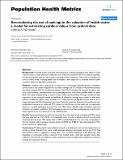| dc.contributor.author | Salomon, Joshua A. | |
| dc.date.accessioned | 2010-11-22T14:38:54Z | |
| dc.date.issued | 2003 | |
| dc.identifier.citation | Salomon, Joshua A. 2003. Reconsidering the use of rankings in the valuation of health states: a model for estimating cardinal values from ordinal data. Population Health Metrics 1:12. | en_US |
| dc.identifier.issn | 1478-7954 | en_US |
| dc.identifier.uri | http://nrs.harvard.edu/urn-3:HUL.InstRepos:4584586 | |
| dc.description.abstract | Background: In survey studies on health-state valuations, ordinal ranking exercises often are used as precursors to other elicitation methods such as the time trade-off (TTO) or standard gamble, but the ranking data have not been used in deriving cardinal valuations. This study reconsiders the role of ordinal ranks in valuing health and introduces a new approach to estimate interval-scaled valuations based on aggregate ranking data. Methods: Analyses were undertaken on data from a previously published general population survey study in the United Kingdom that included rankings and TTO values for hypothetical states described using the EQ-5D classification system. The EQ-5D includes five domains (mobility, self-care, usual activities, pain/discomfort and anxiety/depression) with three possible levels on each. Rank data were analysed using a random utility model, operationalized through conditional logit regression. In the statistical model, probabilities of observed rankings were related to the latent utilities of different health states, modeled as a linear function of EQ-5D domain scores, as in previously reported EQ-5D valuation functions. Predicted valuations based on the conditional logit model were compared to observed TTO values for the 42 states in the study and to predictions based on a model estimated directly from the TTO values. Models were evaluated using the intraclass correlation coefficient (ICC) between predictions and mean observations, and the root mean squared error of predictions at the individual level. Results: Agreement between predicted valuations from the rank model and observed TTO values was very high, with an ICC of 0.97, only marginally lower than for predictions based on the model estimated directly from TTO values (ICC = 0.99). Individual-level errors were also comparable in the two models, with root mean squared errors of 0.503 and 0.496 for the rank-based and TTO-based predictions, respectively. Conclusions: Modeling health-state valuations based on ordinal ranks can provide results that are similar to those obtained from more widely analyzed valuation techniques such as the TTO. The information content in aggregate ranking data is not currently exploited to full advantage. The possibility of estimating cardinal valuations from ordinal ranks could also simplify future data collection dramatically and facilitate wider empirical study of health-state valuations in diverse settings and population groups. | en_US |
| dc.language.iso | en_US | en_US |
| dc.publisher | BioMed Central | en_US |
| dc.relation.isversionof | doi:10.1186/1478-7954-1-12 | en_US |
| dc.relation.hasversion | http://www.ncbi.nlm.nih.gov/pmc/articles/PMC344742/pdf/ | en_US |
| dash.license | LAA | |
| dc.title | Reconsidering the Use of Rankings in the Valuation of Health States: A Model for Estimating Cardinal Values from Ordinal Data | en_US |
| dc.type | Journal Article | en_US |
| dc.description.version | Version of Record | en_US |
| dc.relation.journal | Population Health Metrics | en_US |
| dash.depositing.author | Salomon, Joshua A. | |
| dc.date.available | 2010-11-22T14:38:54Z | |
| dash.affiliation.other | SPH^Global Health + Population | en_US |
| dc.identifier.doi | 10.1186/1478-7954-1-12 | * |
| dash.contributor.affiliated | Salomon, Joshua | |
| dc.identifier.orcid | 0000-0003-3929-5515 | |


